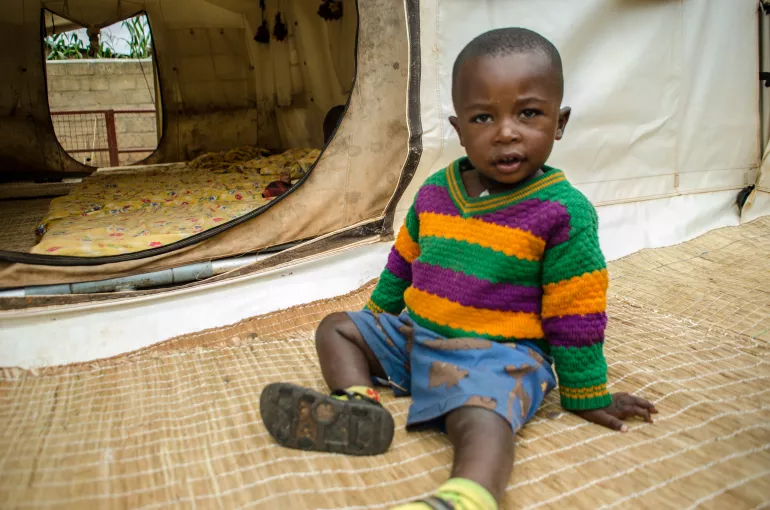Everyone reading this has likely experienced, or knows someone who has experienced, childcare challenges during the COVID-19 pandemic. After all, lockdowns and physical distancing left millions of parents struggling to find childcare while continuing to work. Although more attention has now been given to the childcare issue – in low-income as well as high- and middle-income countries – the specific challenges facing families in acute and protracted crises are still being overlooked.
According to the World Bank, more than 40 per cent of all children below primary-school entry age do not have access to the childcare they need, including millions of children and their caregivers affected by humanitarian crises and the COVID-19 pandemic. Childcare is especially important in humanitarian settings. In these contexts, primary caregivers often have fewer resources and less time to provide socioemotional and cognitive stimulation for their children while taking care of themselves.
In addition, children in humanitarian settings are more likely to be living in unsafe environments, especially during crises with high levels of violence or displacement, putting them at higher risk of abuse and neglect. The provision of childcare is about more than just ensuring that children are being supervised in a safe environment – it’s also an opportunity to provide other services, such as healthcare and nutrition, water and sanitation, stimulation and responsive care and opportunities for early learning, all of which are crucial to early childhood development.
Coping in crises
When high-quality childcare is available, children have the chance to build strong, close relationships with caregivers and receive support managing stress, which is essential in helping them deal with conflict and crisis. It can also bring back a sense of normalcy in their lives. Meanwhile, caregivers – especially women who carry the burden of care because of cultural norms – get some respite from childcare responsibilities, which can boost their mental health and give them much-needed time to work, collect food, access shelter, and/or carry out other tasks to support their families and cope with crisis. Access to childcare also gives young girls, who too often have to care for younger children, an opportunity to attend school.
But what could childcare in emergency context look like? A new brief by UNICEF and the University of Virginia Humanitarian Collaborative identifies critical elements for effective childcare in emergency contexts, and highlights three ways to deliver it:
Mobile childcare creches: These are childcare services, aimed at families on the move or in hard-to-reach places. This model requires little permanent physical infrastructure and is best suited to contexts where access to such structures is difficult and displacement or migration is high and ongoing. For example, mobile creches in Burkina Faso have childcare for participants in public works programmes that moves with the workers.
Childcare hubs: These are simple but more established childcare sites that provide a central location for other Early Childhood Development services. They can serve families along predictable migration routes and are well suited to contexts with low levels of displacement or where previously displaced populations are now relatively stationary. Blue Dot Hubs, for example, can provide safe spaces, vital services, opportunities for play and early learning, protection and counselling for children and families on the move across Europe, such as those serving Syrian and Ukraine refugees.
Home-based childcare: This approach can provide consistency of caregiving in a safe, comfortable environment, either at the home of the child or the home of a provider. This is best suited to contexts where physical infrastructure is still intact or where spaces can safely be rebuilt. A good example is Little Ripples, an early childhood development programme operating in Chad, Tanzania, Cameroon, the Central African Republic and Greece, that provides play-based, trauma-informed childcare services in homes as well as other settings. Community-based programmes can also serve as bridges to more formal settings such as preschools and kindergartens.
These are just a few examples of what is possible. Regardless of the model, it’s essential that the childcare workforce receives adequate training and that childcare services provide children with nurturing care, ensure their safety, address their health, nutrition and early learning needs, are gender transformative, disability inclusive and provide a welcoming and inclusive setting for all families. By providing opportunities for community caregiving, supported by training and income, childcare can also provide a mechanism to improve livelihoods.
A win-win strategy
Ultimately, providing childcare in humanitarian emergencies is a winning strategy for children, women and families. Children are provided with a place to continue to learn and thrive, while caregivers have an opportunity to participate in other activities with reduced stress. We therefore call on the humanitarian community to prioritize the provision of childcare during acute and protracted emergencies. When children experience an emergency, even when their parents are with them, both need support, both need respite, and both need time to address the trauma brought on by emergencies and the stress of leaving behind all that one loves and cares for.
Setting up emergency childcare facilities is a critical step for both caregivers and children and provides the opportunity to address other needs. Childcare is not an extra – it is essential.
About the authors:
Lucy Bassett is Co-director, Humanitarian Collaborative, University of Virginia.
Joan Lombardi is Senior Fellow, Collaborative on Global Children’s Issues, Georgetown University.
Chemba Raghavan is Senior Adviser, Early Childhood Development, UNICEF.
Additional contributors:
Erinna Dia is Associate Director Early Childhood Development, UNICEF.
Shreyasi Jha is Senior Gender Adviser, UNICEF.
Erica Wong-Ciriaci is Early Childhood Development Consultant, UNICEF.





